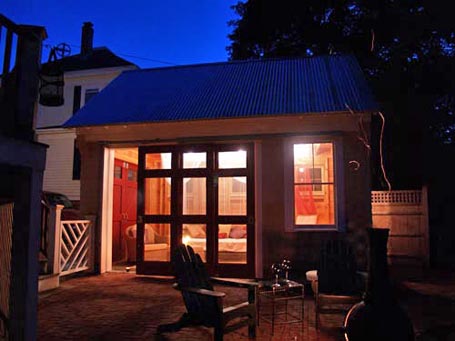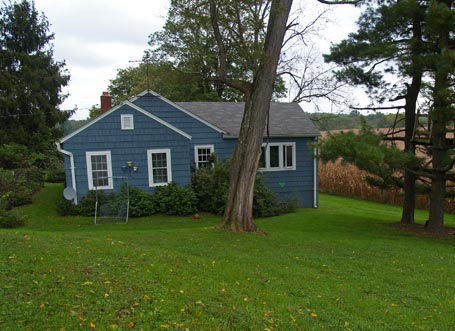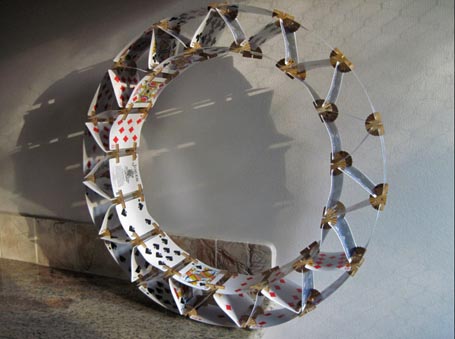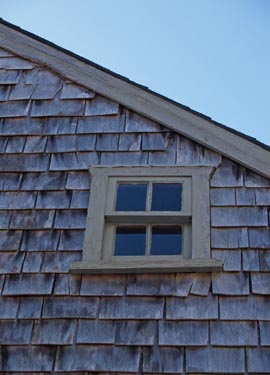
Entries in web tour (50)
Web tour: Custom Home: Current housing trends
 Take It Outside/A Room of One's Own (Manchester Garage/Garden Room by KHS)This week's Design Studio newsletter from Hanley Wood, LLC links to a Custom Home article which features current housing trends cited by architects and designers at this year's National Association of Home Builders International Builders Show. The story highlights 20 of the trends identified by 13 architects and designers in a 90-minute session at the Show.
Take It Outside/A Room of One's Own (Manchester Garage/Garden Room by KHS)This week's Design Studio newsletter from Hanley Wood, LLC links to a Custom Home article which features current housing trends cited by architects and designers at this year's National Association of Home Builders International Builders Show. The story highlights 20 of the trends identified by 13 architects and designers in a 90-minute session at the Show.
I found eight of Custom Home highlights to be particularly relevant. They are titled:
#7. Do the Right Thing.
#10. Gray Power
#11. Micro-'Hoods
#15. In the Pocket
#17. A Room of One's Own
#18. Take it Outside
#19. Dial Up the Density
#20. It Never Hurts to Ask
Follow this link to see the full Custom Home list and explanation in detail.
The architects and designers who participated in the housing trend idea-session are: Jerry Gloss, KGA Studio; Dawn Michele Evans, The Evans Group; Mike Woodley, Woodley Architecture Group; Monica Robertson, Hord Coplan Macht; Mary Dewalt, Mary Dewalt Design Group; Kathy Browning, Design Consultants; David O'Sullivan, O'Sullivan Architects; Todd Hallett, TK Design and Architecture; Mike Rosen, Martin Architectural Group, Cynthia Shonaiya, Hord Coplan Macht; Steve James, DTJ Architects; Scott Adams, Bassenian-Lagoni; Michael Ohara, KTGY Group.
by Katie Hutchison for House Enthusiast
Web tour: Old-House Journal: Sears kit houses
 possible Sears kit house (with addition)We believed the original portion of this little cottage, where my friend and her family lived for years, to be a Sears, Roebuck and Company Modern Homes kit. Its walls and floors were all finished with wood or tile, not a smidge of plaster or Sheetrock -- except in the addition. I'm not sure if my fascination with the Sears kit houses of 1908-1940 was originally sparked by my friend's cottage or if the cottage merely reinforced my fascination. In either case, I continue to marvel at the genius of the Sears Modern Homes program, which endured until the Great Recession and pre-World War II building-material shortages took a devasting toll.
possible Sears kit house (with addition)We believed the original portion of this little cottage, where my friend and her family lived for years, to be a Sears, Roebuck and Company Modern Homes kit. Its walls and floors were all finished with wood or tile, not a smidge of plaster or Sheetrock -- except in the addition. I'm not sure if my fascination with the Sears kit houses of 1908-1940 was originally sparked by my friend's cottage or if the cottage merely reinforced my fascination. In either case, I continue to marvel at the genius of the Sears Modern Homes program, which endured until the Great Recession and pre-World War II building-material shortages took a devasting toll.
I was delighted to find an article in the May issue of Old-House Journal (on newsstands now) about the Sears, Roebuck kit houses of Hopewell, Virginia. I planned to link here to the story on the Old-House Journal website. However, I was disappointed to learn that the story is not yet available online, but, then, I made another discovery in the Old-House Journal article archives. There, I found "The Story on Sears" by Shirley Maxwell and James C. Massey. I'm not sure when the article was written, perhaps ages ago, but it's a great synopsis of how the Sears Modern Homes came to be, evolved, and, ultimately, ceased production.
The popularity of the kit-house concept tends to resurge every so often, as it did in the 2008 MOMA exhibit titled "Home Delivery, Fabricating the Modern Dwelling" which I wrote about here. It seems to me an idea that may again be gaining traction as we begin to emerge from the current recession and the dire lessons of living large and unsustainably. An updated, sustainable, human-scaled kit house, for the way people really live, may, once again, be in order.
by Katie Hutchison for House Enthusiast
Web tour: Skallops (a fun building toy) on Kickstarter
 photo courtesy of the Skallops Kickstarter pageWithin many a house enthusiast is an inner architect, designer, builder in search of an outlet. Search no more. Skallops, a fun buidling toy, awaits your discovery on Kickstarter. Skallops are the ingenious creation of the earnest folks at E&M Labs, LLC. Each Skallop is a little laser-cut, birch-plywood, scallop-shaped clip. Attach playing cards and/or other Skallops to build whatever you imagine.
photo courtesy of the Skallops Kickstarter pageWithin many a house enthusiast is an inner architect, designer, builder in search of an outlet. Search no more. Skallops, a fun buidling toy, awaits your discovery on Kickstarter. Skallops are the ingenious creation of the earnest folks at E&M Labs, LLC. Each Skallop is a little laser-cut, birch-plywood, scallop-shaped clip. Attach playing cards and/or other Skallops to build whatever you imagine.
Skallops will be funded via Kickstarter on February 1, but it isn't too late for you to kick in, and get a Skallop play pack of your own. Get a Starter Pack of 104 Skallops and two decks of playing cards. Or, get the Builder Pack, which includes twice the contents of the Starter Pack. Or, splurge on the Architect Pack, which includes twice the contents of the Builder Pack.
The folks who created Skallops note that, alternatively, you can clip together business cards or cards of your own creation. I'd love to see some Skallop houses. If you create a Skallop cottage or manse, let me know about it at the KHS Facebook Page. Meanwhile, happy building.
by Katie Hutchison for House Enthusiast
Web tour: Scientific American: “Doorway effect” on memory
 At first, I was skeptical of the provocatively titled recent article “Why Walking through a Doorway Makes You Forget” in Scientific American Mind Matters. Then I remembered that only a few days before, I’d gotten up from my desk in my home office to retrieve a pen on my bedside table, and upon entering the bedroom and approaching the table, I had completely forgotten why I had gone in there. Apparently, I was experiencing the “doorway effect”.
At first, I was skeptical of the provocatively titled recent article “Why Walking through a Doorway Makes You Forget” in Scientific American Mind Matters. Then I remembered that only a few days before, I’d gotten up from my desk in my home office to retrieve a pen on my bedside table, and upon entering the bedroom and approaching the table, I had completely forgotten why I had gone in there. Apparently, I was experiencing the “doorway effect”.
According to the article by Charles B. Brenner and Jeffrey M. Zacks, a team of researchers at the University of Notre Dame has been investigating these types of minor memory lapses. They ran a series of experiments which determined that a shift in location, which involves passing into another room through a door and doorway, causes our memory to discard recently experienced memory from the previous room in order to make room in memory for new experiences in the next room. Interestingly, our memory doesn’t seem to discard recent memory when we move an equal distance elsewhere in the same room. It’s the transition through doors and doorways into different rooms that causes the effect. Plus, it doesn’t seem to help if a shift is back into the room where the memory was encoded; we still experience a memory lapse.
It’s fun to ponder the design implications of this kind of scientific finding. Perhaps it’s a good justification for keeping a home office distinctly separate from a home’s other living spaces, lest work pre-occupations seep into family time. Or perhaps it supports more open spaces in a senior living space, such that activities undertaken in a kitchen at one end of a space aren’t forgotten in a dining area at the other end of a space.
I’d be curious to know if the experiment holds true when the doorway doesn’t include a door. What if the doorway is oversized and doorless? Might transitions through column-supported soffits have a similar effect? The scientists note that in one of the virtual space experiments, the difference between the various rooms was reinforced by different wall patterns. What, then, if subjects were to travel between real spaces exhibiting markedly different finish treatments in which a nuanced transition is indicated by an opening in low walls with nothing overhead? Would there be a “doorway effect” beyond the transition? I’d love to know. Here’s hoping there’s more research conducted into the implications of architectural space on our thinking and behavior.
by Katie Hutchison for House Enthusiast
Upgrading energy efficiency in older homes
 If you're an old-house owner in New England who has resolved to improve your home's energy efficiency this year, you may be wondering where to start. Enter Common Sense Preservation, a web portal created in partnership between the Newport Restoration Foundation, Preserve Rhode Island, Historic New England, and the Providence Revolving Fund.
If you're an old-house owner in New England who has resolved to improve your home's energy efficiency this year, you may be wondering where to start. Enter Common Sense Preservation, a web portal created in partnership between the Newport Restoration Foundation, Preserve Rhode Island, Historic New England, and the Providence Revolving Fund.
Visit the site to find informative links for old-house owners in New England who value the historic character of their homes and hope to improve upon their homes' energy performance without breaking the bank.
Frequent House Enthusiast readers may recall my Saving old wood windows rather than replacing them post which touched on one aspect of "green" preservation. I've since discovered another relevant National Trust for Historic Preservation link in support of old wood-window restoration here. Check out the National Trust for Historic Preservation general weatherization guidelines here.
2011 may be the year you finally address those drafty windows, ice dams, and climbing heating bills -- all without sacrificing historic character or wads of cash. Go ahead; get started.
by Katie Hutchison for House Enthusiast















